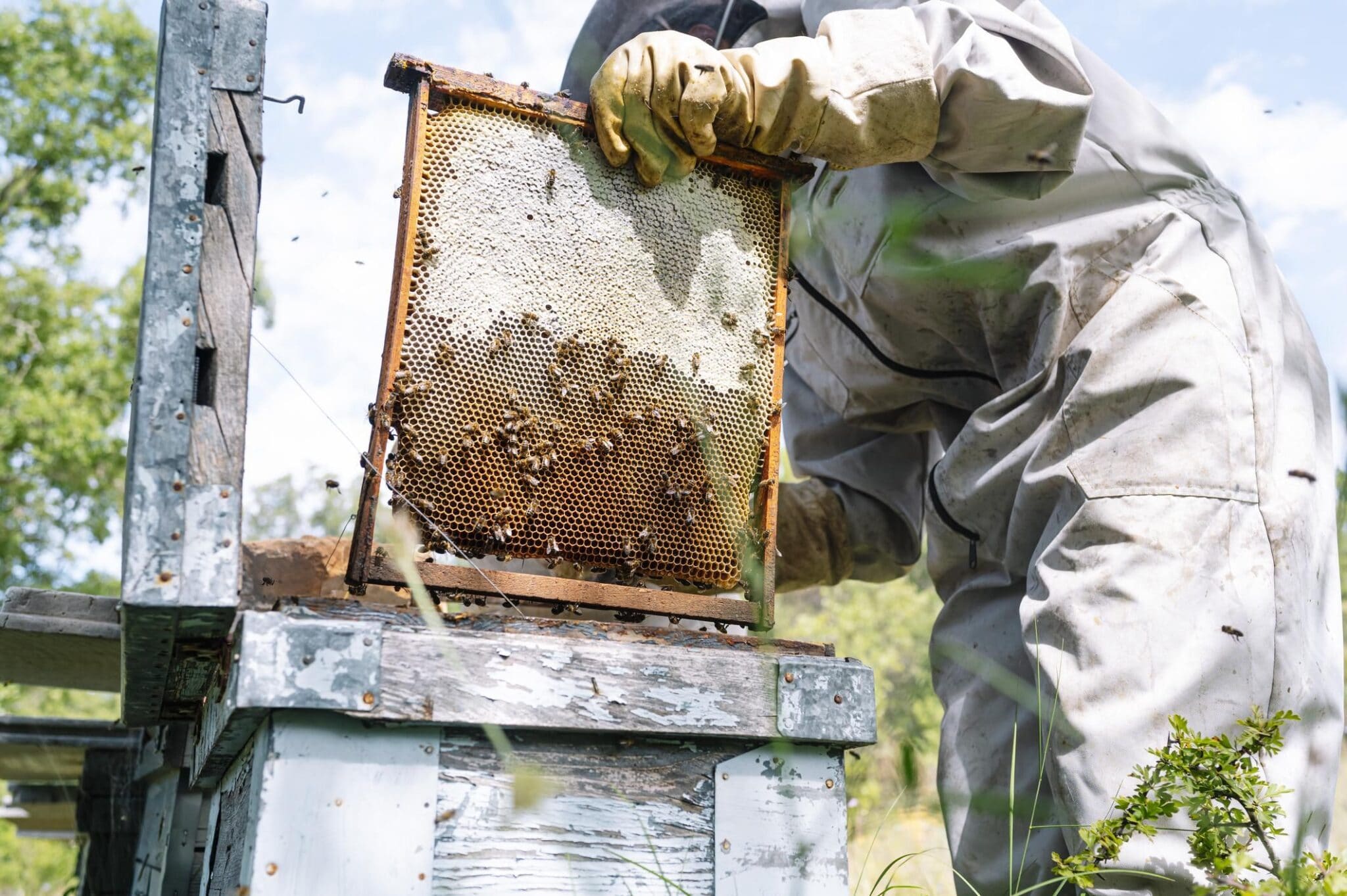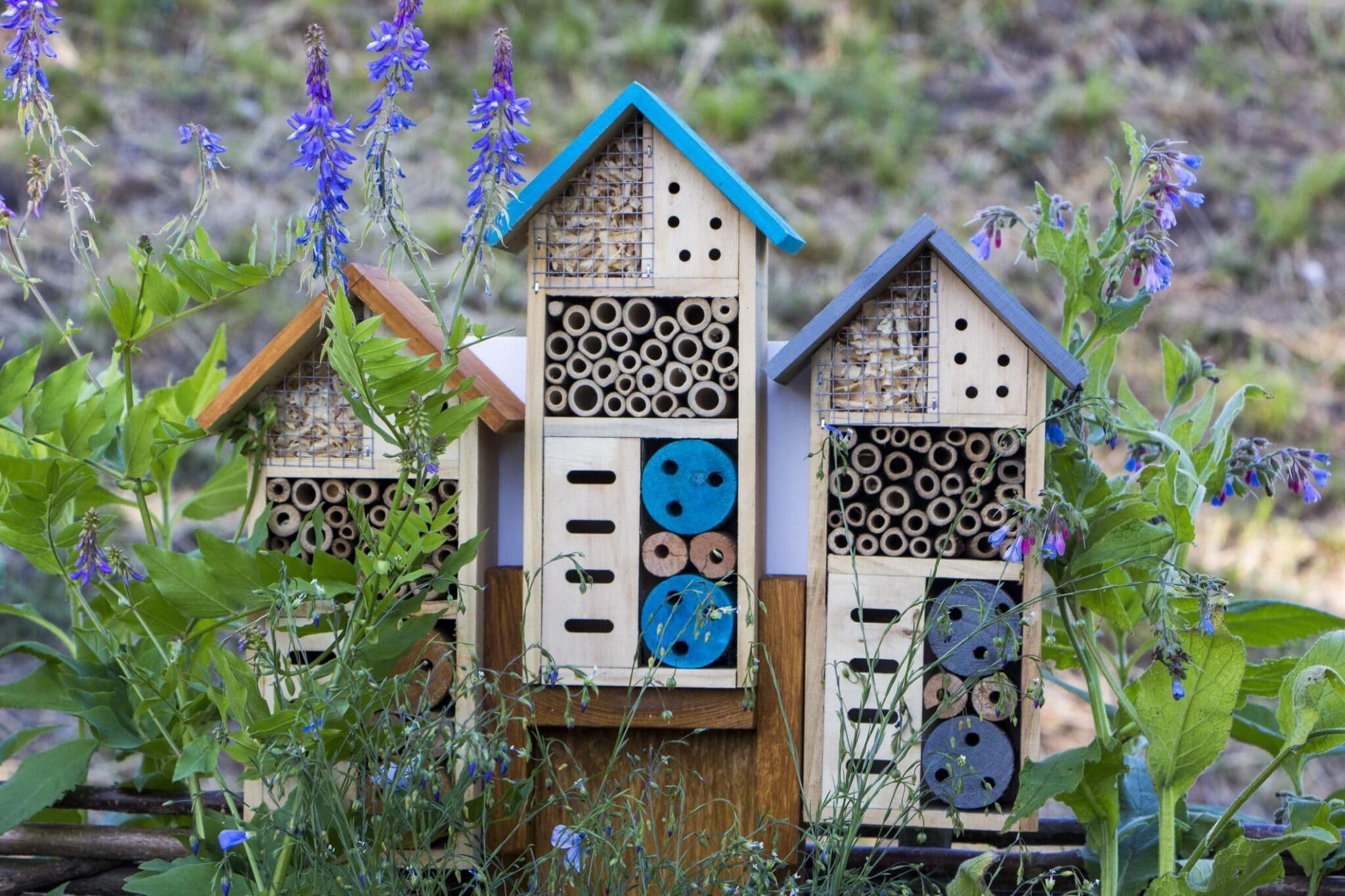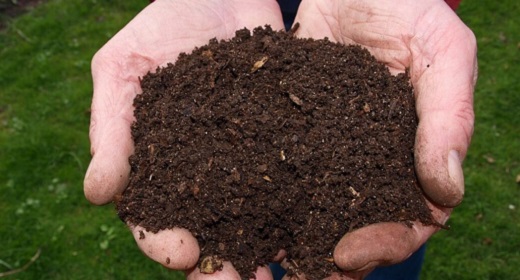by Tiffany Duong: “Save the bees!”
You’ve heard this call to action before, but what’s the buzz really about? Turns out, bees are incredibly important in nature and in human food production.
According to an EarthDay.Org report, there are more than 20,000 distinct bee species worldwide. In the U.S., there are native bees (more than 4,000 species) and commercially managed bees (mostly imported European honeybees). Both are vital for different reasons. The former are wild and keep our forests and meadow ecosystems functioning; the latter are managed by big agriculture to pollinate crops that feed the world.
Unfortunately, most bees are in trouble. Colonies around the world are collapsing and many species are edging towards extinction. Their plight has been described as the death of a thousand cuts, and the causes range from widespread pesticide use to disease to climate change.
So, what can we do? How can we save the bees? Here’s everything you need to know.
Why Are Bees Important?

Westend61 / Getty Images
In short, bees matter because they’re pollinators.
“Pollinators are small but mighty parts of the natural mechanism that sustains us and our world,” Midwest Regional Director Tom Melius said in a U.S. Fish and Wildlife Services (FWS) statement that accompanied the agency’s listing of the rusty patched bumblebee as endangered. “Without them, our forests, parks, meadows and shrublands, and the abundant, vibrant life they support, cannot survive, and our crops require laborious, costly pollination by hand.”
Ecosystem Services
In the wild, many plants rely on pollinators to reproduce and continue growing. Additionally, various animals depend on these plants for their survival. That’s why, according to the EarthDay.Org report, bees are a “keystone species” — they pollinate the food sources of so many other organisms.
In creating floral growth, pollination also provides habitat for insects and birds, the report noted.
Greenpeace described bees as prolific in their work: a single colony can pollinate 300 million flowers each day.
Moreover, bees themselves and the honey they produce are good food sources for many animals.
“Take bees out of the equation, and the effects can be felt all the way up the food chain,” explained another EarthDay.Org article. Bees and other insects keep the food chain working.
This is especially true of native bees.
“Native plants attract native bees,” explained Krystle Hickman, a bee photographer and community scientist. These plants rely on their bees for pollination. Honeybees, which were imported to North America, prefer to pollinate non-native species, she added.
In a commentary piece for Mongabay, Hickman explained how native bees evolved alongside native plants, to which they are adapted. Over millions of years, these plants and their pollinators adjusted to the same changes in climate and habitat. So, saving native bees also means saving native plants and therefore native ecosystems, she said.
Bees Feed the World
Bees similarly pollinate the majority of human food. According to Greenpeace, bees pollinate a “staggering” 70% of crops that feed people, including our fruits, nuts and vegetables.
Greenpeace also reported that honeybees, both wild and domestic, perform roughly 80% of all pollination activities worldwide. This includes everything from asparagus to broccoli, cotton to coffee, noted Heifer.org. Certain crops rely almost entirely on honeybee pollination. Cherries and blueberries, for example, are 90% dependant, and almonds are 100% reliant on honeybees, reported the American Beekeeping Federation. Importantly, honeybees also pollinate alfalfa, an important grass feed for beef and dairy cows.
In the future, “pollination shortfalls” for fruits and vegetables could trigger “nutritional deficits” in diets as fresh foods are replaced by wild-pollinated grains, rice and corn, The Guardian warned.
Economic Impacts
The pollination services that bees provide confer a huge economic benefit to the world. The EarthDay.Org report valued bee-pollinated crops worldwide to be worth $577 billion annually. In the U.S. alone, pollinators contribute $24 billion to the agricultural industry every year through pollination, the report said.
Beyond agriculture, entire industries are also based around bee-derived products like beeswax and honey. If these multibillion-dollar industries collapse, it could put tens of thousands out of work and harm the economy.
Food Security Concerns
Bees, generally, but honeybees, in particular, are “essential to healthy crops, and their rapid decline threatens global food security,” reported Heifer.org.
Scientists forecast that as bee populations continue to decline, the production of food crops will also decrease. Unfortunately, this is directly opposite what the world needs.
Crop yields for key crops like apples, cherries and blueberries are already down across the U.S. because of a lack of bees in agricultural areas, a 2020 Rutgers study found. Because the U.S. is the largest food exporter in the world, the downstream effect of a crop shortage would be massive and global.
As the global population continues to grow — up to 10 billion by 2050, scientists estimate — we will need more food to feed everyone. Without bees, what or who will pollinate the crops?
What’s Happening to the Bees?

Liam Hirst-Graves / EyeEm / Getty Images
So, why are bees dying?
“Habitat loss, acute and chronic pesticide poisoning, diseases and parasites, increasing intensification of conventional farming, and even the impacts of climate change are all taking their toll on bee health,” noted SaveBees.Org. “Many of our bees are sick, stressed, and undernourished.”
U.S. National Agricultural Statistics reported a 60% honeybee hive decline from 1947 (~6 million hives) to 2008 (~2.4 million hives). The Natural Resources Defense Council (NRDC) found an alarming 40% collapse of honeybee colonies from spring 2017 to 2018.
Unfortunately, it’s not just managed bees that are in trouble. In 2017, the Center for Biological Diversity reported that one in four native bee species is at risk of extinction.
“[Certain native] populations are now very small and extremely vulnerable to slight habitat changes,” Mongabay reported.
In 2017, the rusty patched bumblebee became the first wild bee to be listed as endangered in the continental U.S. Once “common” and “abundant,” the species experienced a “swift and dramatic decline” of 87% in the late 1990s and continuing to the present, Mongabay also reported. Only small, scattered populations remain.
Because native bees pollinate native plants, if the bees go extinct, it could also wipe out endangered plant species and disrupt entire ecosystems, the report added.
A ‘Perfect Storm’
Bees are facing a “perfect storm” that threatens their future survival. Who and/or what is to blame for this bee apocalypse?
Human activity is the primary driver, with habitat loss, pesticide use, monoculture farming and climate change wreaking havoc on bees and other insects.
Habitat Loss
Habitat loss, particularly of flowering meadows and fields, is devastating bee populations. As humans industrialize and urbanize, there are fewer places for bees to nest or forage. Less greenery and less diversity of plants in and around suburbs and cities mean bee habitats have become fragmented. What’s left are “pollinator deserts” that have replaced once abundant wildflower meadows, SaveBees.Org reported.
Pesticides vs. Pollinators
The rise of commercial agriculture brought about increased pesticide use. These chemicals, especially those in the neonicotinoid family, have decimated bee populations.
Pesticides kill bees or weaken bee immune systems, leaving them more prone to diseases and parasites, SaveBees.Org reported. Still, the toxins are widely used both commercially and in homes. For example, undisclosed “inert” ingredients in Roundup are lethal to bumblebees, but the product remains on shelves.
A 2019 study found that agriculture became 48 times more toxic to insects in the U.S. between 1992 and 2014, largely because of neonicotinoid use.
“While climate change, habitat loss, and disease all play a role in the rate of colony collapse, mounting scientific evidence links the recent dramatic spike in bee deaths to the rise of neonic (short for neonicotinoid) pesticides — now the most heavily used insecticides in the United States,” reported the NRDC.
Neonicotinoids can kill bees “on contact” and even trace exposures harm their ability to navigate, forage, and reproduce, the environmental organization noted.
Daniel Raichel, who is the NRDC’s acting director of their pollinator initiative, called neonicotinoids “phenomenally toxic” to bees and other animals. These chemicals easily spread through soil and water, getting absorbed by wild plants. The pesticides are designed to be absorbed by every part of a plant, to “make the plant itself the pesticide,” Raichel explained to EcoWatch. Thus, pollen and nectar from crops treated with nicotinoids become poisonous to bees and other pollinators.
“One neonic-treated corn seed can have enough active ingredient to kill a quarter-million bees or more and one square foot of neonic-treated lawn, at the EPA approved label rate, can have enough active ingredient to kill a million bees,” Raichel explained.
Companies are aware of the devastating effect of pesticides on pollinators, but continue to evade and market around such facts because the chemical business is big money. How much? A 2020 report from Unearthed showed that the world’s top five pesticide makers are making billions from chemicals that have been proven hazardous to humans, the environment and bee populations.
Monoculture, Multiple Problems
Habitat loss and pesticide use correlate with the rise in farming to meet food demands from a growing global population. As industrial agribusiness converted grasslands and forests — wild bee habitat — into monoculture farms overridden with chemicals, bee populations plummeted, Greenpeace reported.
Monoculture farming involves planting only one crop over a large area over and over. Rather than rotating crops to naturally restore soil nutrients and vitamins, monoculture farming depletes soils and invites weed and pest invasions, One Green Planet explained. That’s why this type of farming often requires heavy pesticide, fertilizer and fossil fuel use to ensure maximum yield, Down to Earth reported. In the U.S., this is now the dominant farming practice.
To pollinate massive fields of monocrops, farmers often employ migratory bees. These are trucked-in European honeybees that are shipped across the U.S. to pollinate crops like avocados and almonds. U.S. farming couldn’t function without this practice, but critics warn against its use.
The practice could stress, injure or kill bees, CNN reported. Also, forcing bees to gather pollen and nectar from a single, monoculture crop — the one they’ve been recruited to pollinate — means they receive fewer nutrients than they would with a natural, varied diet, Scientific American reported.
Finally, the report added, the shuttling of bees from area to area guarantees the spread of viruses, mites and fungi between the managed bees themselves and with native bees and other insects.
Climate Crisis and Environmental Threats to Bees
If the deadly combination of habitat loss, toxic pesticides and industrial agriculture wasn’t enough, there are also environmental threats to bees.
For instance, research has found that pollutants linger on the bodies of honeybees in areas with high levels of air pollution, exposure to diesel exhaust interferes with their foraging ability and air pollution may affect the heart and immune systems of wild honeybees.
Climate change is also complicating things. A Feb. 2020 study found that bee populations experienced the largest decline in places that have warmed at a faster rate than the rest of the planet. The result, scientists warned, could be the extinction of the bumblebee due to the climate crisis.
“Our results show that we face a future with many less bumblebees and much less diversity, both in the outdoors and on our plates,” said Peter Soroye, lead author of the study.
Different species of bees have also evolved to feast on certain blooms and during certain times of the year. As global temperatures shift, flowers could bloom earlier or later in the season, reducing the time that bees have to feed on them, the EarthDay.Org report said. Additionally, climate change could cause species of plants that bees rely on to go extinct, and conditions for life could otherwise become inhospitable for bees.
Disease, Mites and Parasites
These multiple, overlapping factors continue to affect bee populations negatively and make them more susceptible to diseases and pests.
For example, in late 2020, a single-celled fungal pathogen called Nosema emerged as the latest threat to bees. Nosema reproduces in a bee’s gut, where it ruptures, spreads and infects the rest of the digestive tract. It leads to lethargy, reduced foraging ability and directional sense, and, often, death. Once one bee in a colony is affected, the fungus spreads quickly because hives are crowded. This can lead to total colony collapse.
Also, when infected bees visit flowers, they can leave the pathogen on surfaces that other wild pollinators land on. This “community spread” of insect diseases has been called a “pandemic” in its own right.
Finally, the Varroa mite is harming many bees. This parasite attaches to the bodies of honey bees and sucks their fat tissues, a PNAS report found. This weakens adults and can kill juvenile bees. Unfortunately, the mite is also a vector for at least five debilitating bee viruses. A significant mite infestation can kill an entire honey bee colony.
How Can We Save the Bees?
That brings us to how we can save the bees. Just like there are multiple threats endangering bee populations, so too there are numerous actions one can take to help. We can start by reversing the major threats to bees we’ve already covered.
| Threat | “Reversal” as Solution |
| Habitat Loss |
|
| Pesticide Use |
|
| Monoculture Farming and Migratory Beekeeping |
|
| Climate Change and Air Pollution |
|
| Diseases, Mites, and Parasites |
|
Keep a Bee Garden & Hotel
The most accessible solution is to give bees more food, water and shelter.
Plant native wildflowers and flowering shrubs at home and in community plots. Ideally, you’ll choose native flowers that bloom at different times of the year to nourish as many different species of bees as possible. Fruit trees such as apples, pears, plums and cherries are also excellent pollinator food sources, SaveBees.Org recommended, as are vegetable and herb plots. Even small balcony gardens help passing pollinators rest up and rejuvenate.
Or, dig up a part of your lawn and convert it to meadow — prime native bee habitat — by replacing grass with native wildflowers and no-mow areas. Dandelions, in particular, are pollen-rich and last very long in the year. They feed a great variety of bee species.
Germany has taken this solution to a national scale, with a country-wide project to plant urban wildflower meadows. As of June 2021, more than 100 flower and wild grass beds have been planted in Germany’s largest cities to aid their 580 species of native bees. The meadows include endangered native plants as well as annual blooms selected to bloom year-round.
Next, provide water for bees and other insects to drink. With fragmented habitats, bees can get dehydrated searching for nectar. Help by creating a shallow water bath with sticks or stones for bees to land on. Replace standing water weekly to prevent mosquitoes from developing.
You can also create simple bee “hotels” out of scrap wood and packing materials for native bees. Most native species nest in wood, dried stems or in the ground, SaveBees.Org reported. Providing similar materials nearby to flowers and water can allow these bees to get through their winter season. Experts recommend sanitizing the “hotels” between seasons to avoid pests, diseases and cross-contamination.

In the U.S., you can also support the Biden administration’s infrastructure agenda, which includes funding for pollinator-friendly roadsides and the removal of invasive species alongside traditional infrastructures such as roads and bridges.
Ban or Reduce Pesticide Use — Especially Neonicotinoids
Mounting evidence shows that we must address our overuse of pesticides if we are to save the bees. Several government bodies are doing so. For example, the nation of Bhutan has adopted a 100% organic farming policy, Greenpeace reported. Also, the European Union voted to ban outdoor use of three major neonics, and Canada is moving towards curtailing its use of chemicals, the NRDC reported.
The U.S. has thus far failed to take significant federal action.
“…The U.S. Environmental Protection Agency has so far failed to act. That’s why NRDC is putting pressure on the EPA, both in and out of court,” the organization said.
Meanwhile, some states are taking up the fight: Connecticut, Maryland and Vermont have banned the sale of bee-killing pesticides to consumers, Environment America reported. The NRDC is simultaneously working with other states to promote smart pesticide policies and to build pollinator habitats while pushing major retailers to take neonic products and neonic-treated plants off their shelves.
As an individual, you can urge Congress to ban Neonicotinoids right now and to pass the Saving America’s Pollinators Act, EarthDay.Org recommended. The organization also asks individuals to sign their Earth Day Network’s Pesticide Pledge to reduce pesticide use.
As a consumer, you can also reach out to large companies to demand they stop selling bee-killing products. The power of social movements should not be underestimated.
Swap Monoculture for Ecological Farming
Monoculture is not the way to go if we are to protect the future of bees. Alongside diversifying crops, Futurity also recommended increasing the diversity of managed pollinators and investing in honeybee colonies. This can help avoid diseases and colony collapse within current agricultural systems.
Greenpeace called these “big agriculture” systems, with their monoculture farms and widespread pesticide use, “dysfunctional and destructive.” The organization instead advocates for “ecological farming” as a way to stabilize human food production, preserve wild habitats and protect the bees.









































